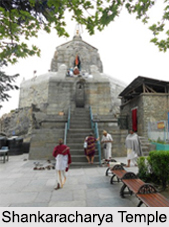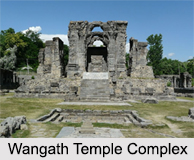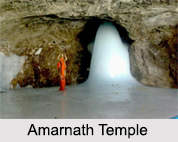 Temples in Jammu and Kashmir are no exception. They serve as spots that have the potential to catch the attention of tourists visiting this state. The state of Jammu and Kashmir is located in the northern part of India. The geographical terrain of this state is characterized by natural beauty and some popular monuments. There are several temples in Jammu and Kashmir that have been historically significant as well. Some of the temples have been detailed below:
Temples in Jammu and Kashmir are no exception. They serve as spots that have the potential to catch the attention of tourists visiting this state. The state of Jammu and Kashmir is located in the northern part of India. The geographical terrain of this state is characterized by natural beauty and some popular monuments. There are several temples in Jammu and Kashmir that have been historically significant as well. Some of the temples have been detailed below:
Shankaracharya Temple: This is one of the most popular temples in Jammu and Kashmir. It is located at an elevation of about 1,852.16 meters on top of the Shankaracharya hill, which is also known as the Gopadari Hill in the district of Srinagar. This temple is dedicated to Lord Shiva; a Shiva Linga was placed in the temple during the 19th century.
Shankaragaurishvara Temple: Shankaragaurishvara Temple is situated in Pattan, near Baramulla. This temple is also dedicated to Lord Shiva. Shankaravarman, who once ruled Kashmir, is credited with the establishment of this temple. This temple represents Kashmiri style of architecture.
Wangath Temple Complex: Wangath Temple Complex is located in Wangath close to Naranag in the Ganderbal district of Jammu and Kashmir. Among several temples in Jammu and Kashmir, this group of monuments has been declared as the centrally protected monuments of India by the Archaeological Survey of India. The primary deity of this complex is known to be Lord Shiva.
 Raghunath Temple: Raghunath Temple is located in the district of Jammu. This temple is regarded as one of the largest temple complexes of north India. This temple was constructed during 1835-1860. Lord Rama, a form of Lord Vishnu, is known to be the ruling deity of this temple. The temple was built by Mahant Narottam Das.
Raghunath Temple: Raghunath Temple is located in the district of Jammu. This temple is regarded as one of the largest temple complexes of north India. This temple was constructed during 1835-1860. Lord Rama, a form of Lord Vishnu, is known to be the ruling deity of this temple. The temple was built by Mahant Narottam Das.
Mata Sarthal Devi Mandir: Mata Sarthal Devi Mandir is one of the most important temples in Jammu and Kashmir. It is housed in Sarthal near Kishtwar. Dharmarth Trust is known to be the managing body of this temple. Under the patronage of Raja Agar Dev of Kishtwar, Sarthal Devi Mandir was made using stones. Using the wood of Dayalwan and Deviyun-van forests, Sarthal Devi Mandir was refurbished in the year 1936 by Maharaja Hari Singh.
Vaishno Devi Mandir: Temples in Jammu and Kashmir also include Vaishno Devi Mandir, which is one of the most famous pilgrimage sites of India. It is situated in Katra on the Trikuta Mountains. This temple is dedicated to Vaishno Devi, an incarnation of the Hindu mother goddess, Mahalakshmi. Vaishno Devi is also known as Mata Rani, Trikuta and Vaishnavi.
 Amarnath Temple: Surrounded by fairly steep hills, the Amarnath temple is considered to be one of the oldest temples in Jammu and Kashmir. The temple dates back to the 5th century. This temple, dedicated to Lord Shiva, is situated near Lidder Valley in Pahalgam tehsil of Anantnag district at an altitude of 3888 meters. The temple is famous for a Shiva Linga; it is a natural formation of ice, which occurs in the month of July/August. This formation is believed to wax and wane according the moon`s cycle.
Amarnath Temple: Surrounded by fairly steep hills, the Amarnath temple is considered to be one of the oldest temples in Jammu and Kashmir. The temple dates back to the 5th century. This temple, dedicated to Lord Shiva, is situated near Lidder Valley in Pahalgam tehsil of Anantnag district at an altitude of 3888 meters. The temple is famous for a Shiva Linga; it is a natural formation of ice, which occurs in the month of July/August. This formation is believed to wax and wane according the moon`s cycle.
Sudh Mahadev Temple: This temple is located at a distance of 8 km from Patnitop. It is devoted to Lord Shiva. The temple of Sudh Mahadev was constructed by Chaudhari Ramdas of Chanhani and his son Chaudhari Parag Mahajan about 80 years ago. Located at a height of about 1225 meters above sea level, the temple offers an astounding view of the nearby hills and landscapes.
Other Temples in Jammu and Kashmir
There are some other temples in Jammu and Kashmir apart from the above ones. The names of those temples are Sun Temple, Sharika Devi Temple, Ranbireshwar Temple, Peer Kho Cave Temple, Avantipur Temple, Baboor Temple, Buddha Amarnath Temple, Shri Guru Nanak Dev Ji Gurudwara, Nangli Sahib Gurudwara, etc.











